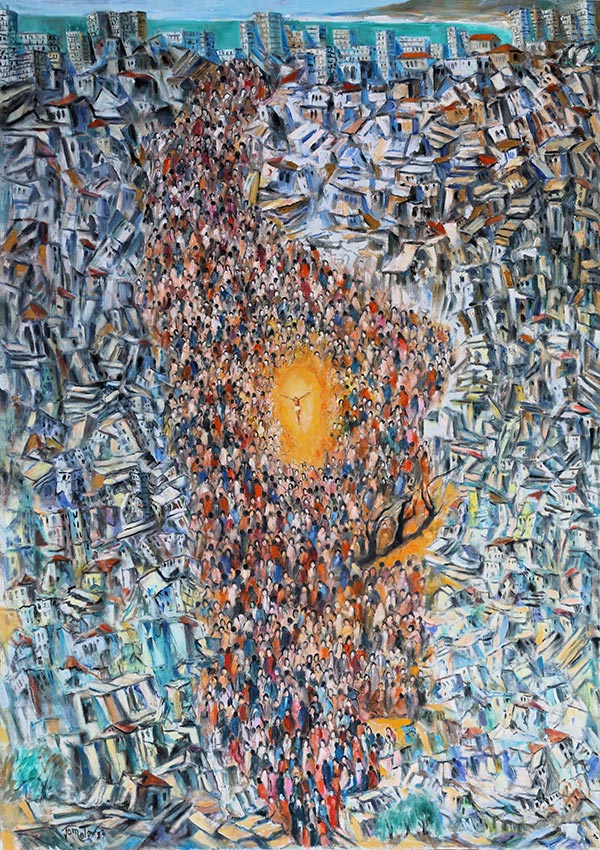The Redeemer in the Sky of Gaza
The work on YouTube – Short on YouTube
I have always been committed, in my career as a painter, as a university professor, or in my familial life and relationships. Sometimes, neutrality itself was a commitment.
In the choice of my themes as well – the themes impose themselves before I even think about them: a tsunami, an earthquake, and its aftermath, an extraordinary event, a universal act, or a major human event. My emotions, my opinions on national, social, and religious events, my feelings, visions, and humanism make me a truly human being on this planet Earth. I mean, if an event unfolds in India, Ireland, Europe, or elsewhere, its repercussions unfold in my soul, and I feel committed to taking sides and being close to my fellow human beings, regardless of their colors, religions, or nationalities. All problems on this Earth can be solved with love and understanding: Abbé Pierre, Gandhi, Mother Teresa, etc., are such examples.
A war that erupts anywhere erupts also in my soul, and its repercussions shake me, resonate in me, paralyze me, and often I feel compelled to express my sensations. The flame that burns me is translated into a pictorial, plastic poem; this is to satisfy my need to accomplish this creative act and give it a material form that can be loved or not, criticized, accepted, and judged. It is an artist’s cry like any other poem.
The artwork speaks, screams, and addresses the viewer. Its mission is a mission of love, mutual aid, and human understanding; this is not strange in my work. I am persistent in my work; I review the artwork dozens of times to reach a point that I find satisfying. Here I enter the current theme that I have been lovingly chiseling for almost three months, and I have never been afraid to redo the work, erase, and attack the artwork again.
A war, not far from Lebanon, in Gaza, a deadly war, without respect nor mercy, is no longer a war but a massacre. Massacres of children, civilians, blind vengeance killing everything that lives, pounding constructions, plowing the land… Instead of this war, negotiation could have been possible, without ruining an entire country, killing thousands of people, and causing a global crisis for the rest of the planet.
As soon as hostilities began, I had hundreds of sheets in front of me where I noted, made sketches, and compositions for an upcoming painting dealing with current events after a long very hard work, and sleepless nights. I started my painting in stages, thinking about the structure of my composition. What I saw on television and in the press was very useful as documents.
Here, the creative act is at stake; documents piled up in front of me, are only part of the artwork. A document must be felt, and experienced, giving it maximum expression.
The research is serious and necessary, but that’s not all; the moment will come when the artist will assimilate the whole ensemble into his soul and create a balanced, constructed, solid, poetic artwork that cries out, speaks, inflames emotion, a rich and expressive artwork… Achieving poetry is the ultimate creation.
Since I am talking about Gaza, let’s stay there. It’s Gaza and all the events that unfolded there: bombings, massacres, killings of children, famine, fear, misery, suffering… heroism, courage, sacrifices, and assistance too.
I started with three pentagons (a geometric figure with 5 sides). It was the first structure of the artwork where the drama, tragedy, massacre, genocide, total destruction unfolded on a large canvas 162.5×114 cm with a background scattered with ruins. On this background, a mass of human beings is “thrown, poured haphazardly,” in the center an empty space, a cosmic hole where the “Savior of the World,” Christ, Savior of all humanity, appears.
Fraternity is a duty to others. Christ is there present before the injustice suffered by his creatures. I am happy to execute such artworks because they require a lot of love, will, and ability in this game of creativity.
The artwork is created by the artist; it is the creative act that fascinates me and is my mission.
Several times I revisited certain parts that I thought they lacked solidity and expression; this is the difficult side of creating an artwork. Art is very difficult for those who know; it is not a hobby, a cinematographic movie, or a walk… the artist must have a certain level of culture, and reading the great masters is absolutely necessary, Rembrandt, Vermeer, Michelangelo, Leonardo, Delacroix, Ingres, etc…
I did not imagine that painting “destruction” was so difficult because it has no norm.
Human beings thrown in handfuls on this mass of ruins, on this patriotic land that is theirs, the land of their ancestors, their heritage… You see some charred tree trunks, one or two still green olive trees, and in the upper part of the canvas, intact buildings and a beach that follows the Lebanese coast, Sidon, Tyre, and where you see the horizon. This suggests that reconstruction will begin one day.
Hope is part of the artwork; life will resume, and the presence of Christ in a flaming sky increases our hope for deliverance.
Joseph Matar
Adaptation by Mayda Samaha



